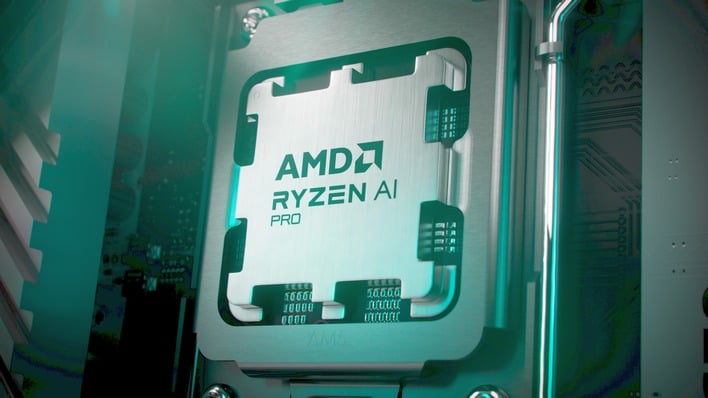
There’s no doubt about it: AI will change all of our lives, and there’s no going back. Still, there’s a lot of debate about exactly how it happens. If you listen to hardware vendors like AMD and Intel, they’ll tell you that you absolutely need to upgrade your enterprise computers to new “AI PCs”—PCs with built-in AI acceleration. That’s the goal of a slideshow like this:

Whether you think generative AI is ready for prime time or not, there are plenty of clear arguments that it’s worth upgrading to the latest hardware. As always, the latest chips are built using the latest process technologies and feature the latest core architecture from each vendor. In AMD’s case, that means Zen 4 CPU cores, RDNA 3 graphics cards, and “XDNA” Ryzen AI Neural Processing Units (NPUs).
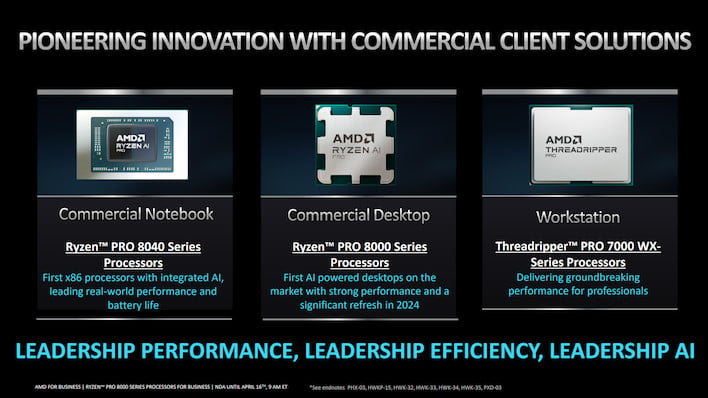
As of now, AMD has taken a three-pronged approach towards client CPUs for business users. The top end is the Threadripper Pro 7000 series processors, which we’ve reviewed several times before. For users who don’t need a lot of multi-core throughput, there are Ryzen PRO 8000 series desktop CPUs, and for laptops, we can choose Ryzen PRO 8040 series mobile processors.

It doesn’t take a genius to figure out that these parts are essentially the same hardware as the Ryzen 8000G desktop CPUs and Ryzen 8040 series mobile CPUs launched earlier this year. All of these parts are based on “Hawk Point” chips, but the PRO versions of these processors do offer some extra features over the standard models. We will discuss these at the end. First, let’s take a look at the chips.
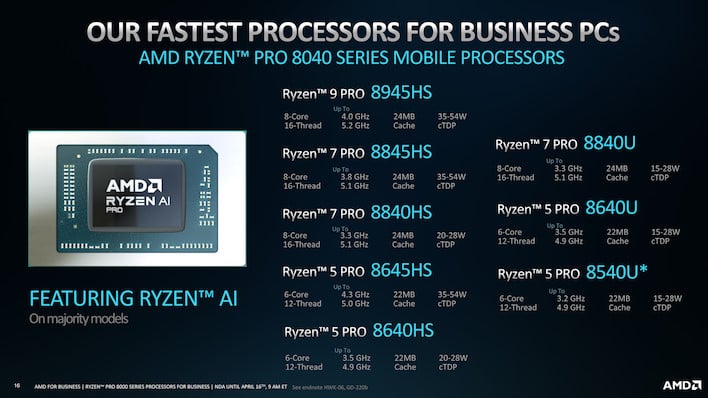
On the mobile side, we have parts from the Ryzen 9 PRO 8945HS all the way up to the Ryzen 5 PRO 8540U. All models ending in “45” have a configurable TDP between 35 and 54 watts for HS parts, and a configurable TDP between 20 and 28 watts for “40HS” parts. Meanwhile, the “U” part has the usual 15-28W TDP range. Of course, all of this can be configured by the system vendor.
Since the Hawk Point chip only has 8 CPU cores in a single CCX, there isn’t much difference between the parts. The Ryzen 5 PRO 8540U misses out on the Ryzen AI NPU, some of which may affect the performance of its GPU hardware, but if so, AMD didn’t specify in its materials today.
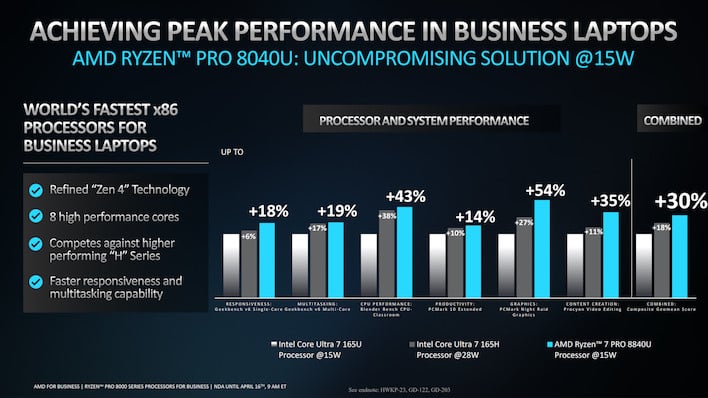
However, AMD fares strongly against Intel in today’s launch. In this slide, we see the Ryzen 7 PRO 8840U configured at 15W TDP, compared to the Intel Core Ultra 7 165U and 165H processors at 15W and 28W TDP respectively. Despite Intel’s TDP advantage, at least according to AMD’s calculations, AMD’s processor outperformed the Intel chip by a whopping 54 percent in this set of benchmarks.

In this slide, AMD compares office productivity using the UL Procyon benchmark suite. This set of benchmarks uses Microsoft Office applications installed on the system itself to perform various automated tests. If we believe AMD’s numbers, its Ryzen 7 PRO 8840U (only 15W) is claimed to be 70% faster than the Intel Core Ultra 7 165H (28W). We were impressed when we tested the Core Ultra 7 165H in the MSI Prestige 16 AI EVO, which means these parts have to be really fast, otherwise the extra 16GB of RAM in AMD’s test platform gave it a big advantage over the Intel platform.
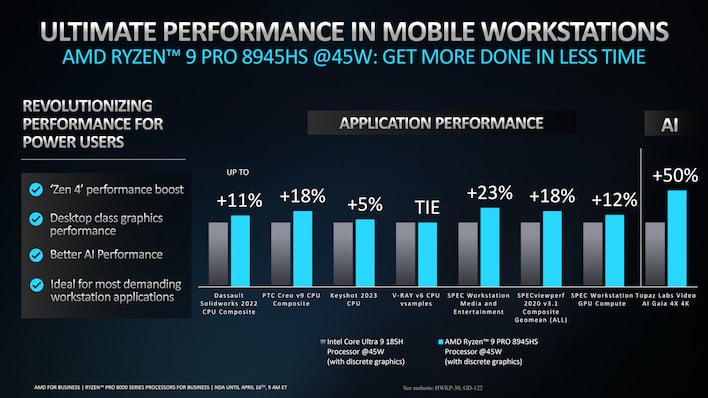
Comparing high-end laptop parts to discrete GPUs, AMD once again claims the performance lead, this time against Intel’s Core Ultra 9 185H. Although AMD highlighted a 50% performance advantage over Intel’s fastest Core Ultra CPUs in the Topaz Labs AI-powered video upgrade, overall the gains here are smaller, if not larger inside AMD’s test bed. With a discrete GPU, this would be impressive for an Intel device (according to AMD’s own testing instructions.)
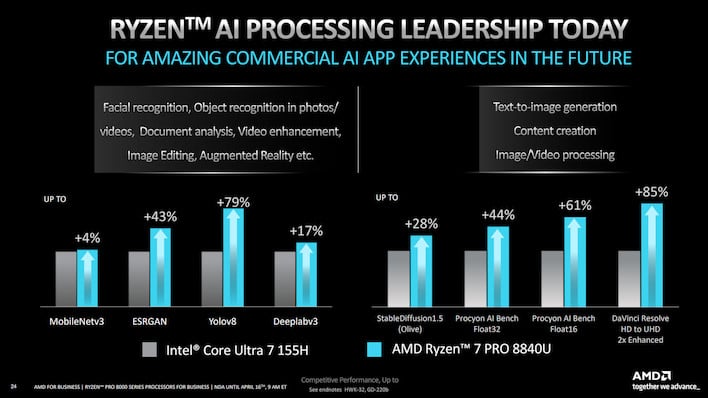
Of course, considering these are the first Ryzen PRO processors with NPUs, AMD has to beat the competition on some AI workloads. However, we must note that AMD did not explicitly state that an NPU is actually used here. In our own testing, we found that AI processing is faster using the integrated GPU on mobile chips than using the NPU on both AMD and Intel. It’s not quite clear what’s being compared here, but AMD claims to be 85% faster than Intel in these tests.
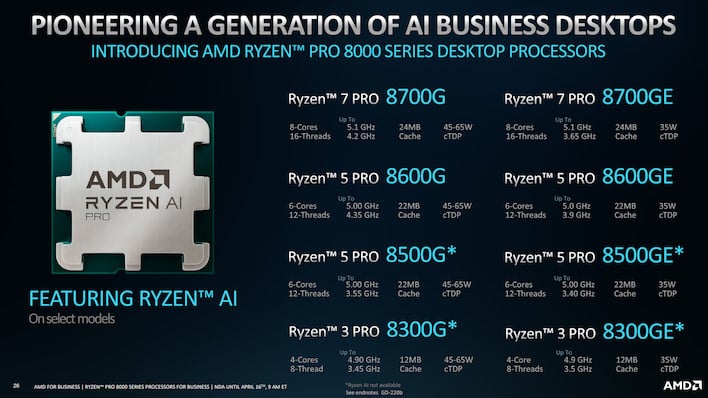
On desktops, we see a more diverse selection of SKUs, with fewer SKUs with Ryzen AI built-in. Once again, the parts are essentially the same as AMD’s Ryzen 8000G desktop processors launched in January, just with Pro features enabled. As usual, the base TDP of the “E” models is reduced, while the lower-end parts of the standard and “E” series lose the NPU.
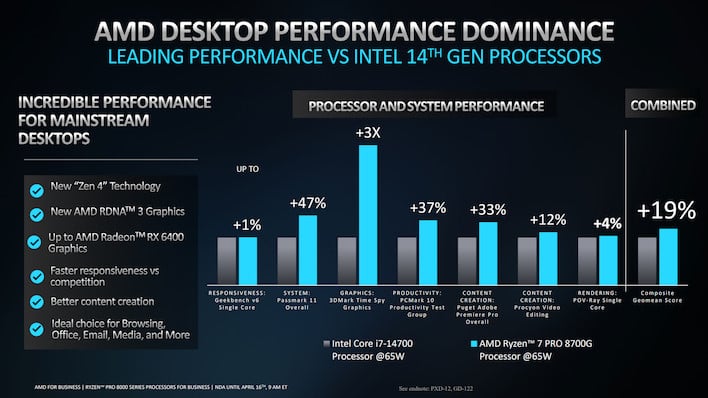
AMD rarely reveals the performance of its Ryzen PRO 8000 desktop CPUs, but there are still some very interesting claims here. AMD says its 65-watt Ryzen 7 PRO 8700G is faster than the Intel Core i7-14700 with the same TDP in quite a few productivity tests. Of course, the biggest draw is the triple performance in the 3DMark Time Spy graphics test, but a lot of that comes down to the fact that we’re comparing a classic desktop CPU with minimal graphics against a truly repurposed mobile processor that was once labeled “Brand”) for comparison. Auxiliary power unit. ” Still, the gains for other applications are impressive, especially considering we’re comparing an 8-core CPU to a 20-core chip.
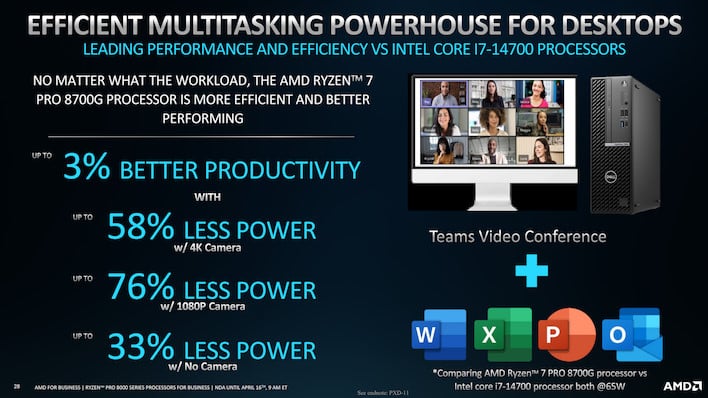
Another factor that makes the performance difference even more surprising is that the Ryzen 7 PRO 8700G consumes less power than the Core i7-14700. AMD emphasizes the power efficiency angle of these parts, though we have to point it out in this slide: “AMD Ryzen 7 PRO 8700G processors are more efficient and perform better regardless of workload.” This is a big one for AMD statement, but the data it provides is convincing, and we didn’t see any obvious “issues” in the test data provided.
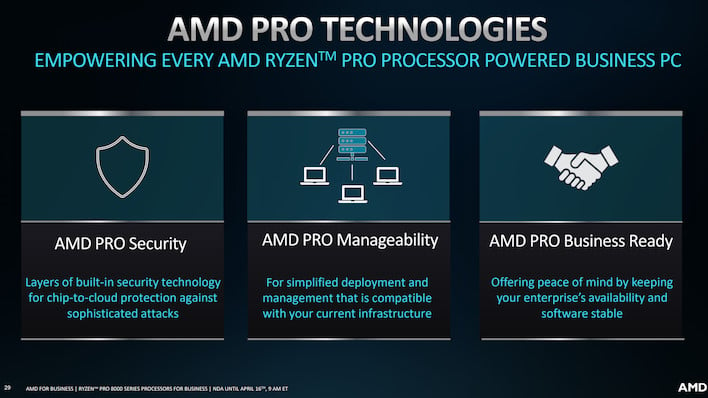
If you’re reading this and actually considering buying an AMD Ryzen PRO, you probably already know what the “PRO” badge means, but just in case, let’s talk about it a little bit. AMD’s PRO CPUs offer the same performance and efficiency as their standard Ryzen CPUs, just with some extra business-oriented features. These include additional security features (such as AMD Shadow Stack and Pluton security processor), remote management capabilities (such as support for Windows Autopilot and cloud-based remote manageability), and longer support periods.
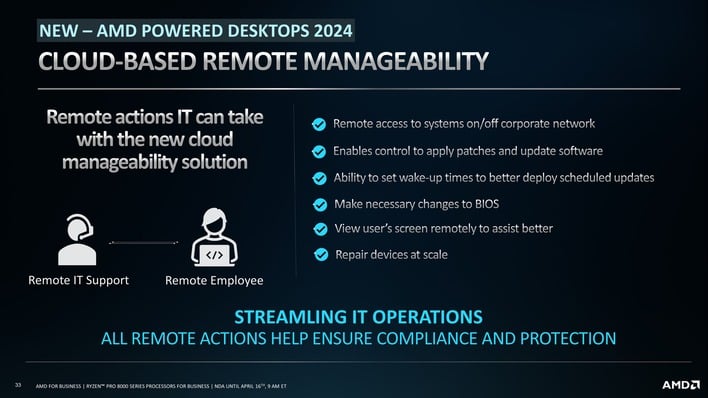
AMD specifically noted how the new cloud-based remote management capabilities of its Ryzen PRO 8000G desktop CPUs can streamline your IT operations by allowing remote technicians to remotely perform almost anything they can do with the machines at hand.
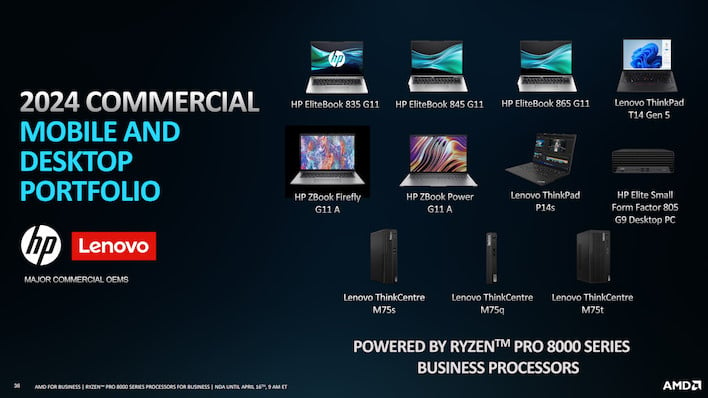
AMD’s usual partners for this launch are HP and Lenovo. The company notes that all of the above hardware is coming soon, so sooner or later you’ll be able to pick up a mobile machine or tiny workstation equipped with the new Hawk Point chip. Time will tell whether the AI part of these Ryzen PRO 8000 processors ends up being truly useful, but even if the NPU is completely absent, you’re still looking at an extremely performant and efficient CPU. This makes the Ryzen AI NPU almost like the cherry on top of AMD’s 2024 commercial CPU portfolio.